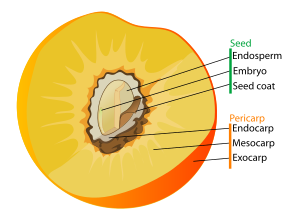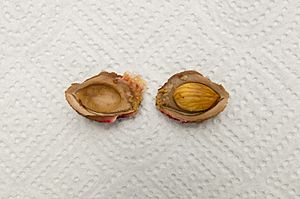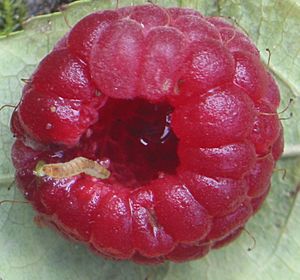Stone fruit facts for kids

A stone fruit is also called a drupe. It's a type of fruit that has a large, hard "stone" inside. People sometimes call this stone a seed, but that's not quite right. The real seed is actually hidden inside the stone! These stones are also known as pits.
Some common examples of stone fruits you might know are peaches, nectarines, plums, lychees, mangoes, and cherries. These fruits are delicious to eat and are often used in cooking.
What we call a "fruit" in everyday talk can be different from what a botanist (a scientist who studies plants) calls it. For example, not all drupes have one big stone. Think about raspberries! If you carefully break open a raspberry, you'll see many tiny stones inside. They are called stones because the seeds have a special covering, not because they are big and hard.
Each of the small, round parts that make up a raspberry has a tiny pit inside. These little parts are called drupelets, which means "little drupes."
Contents
What are the different types of stone fruits?
When we talk about stone fruits, we often mean fruits from the Prunus family. This family includes many popular fruits like peaches, plums, and cherries. But the term "drupe" is a bit wider and includes other fruits too.
Freestone vs. Clingstone Fruits
Have you ever tried to cut a peach and found the stone stuck to the flesh? Or did it pop right out? That's the difference between freestone and clingstone fruits!
Freestone Fruits
Freestone fruits have a stone that you can easily remove from the fruit's flesh. The flesh isn't attached to the stone, so you don't need to cut around it to get the stone out. Freestone fruits are great for things like making homemade prunes from plums or pies from sour cherries. This is because it's much easier to remove the pit when you're preparing a lot of fruit.
Clingstone Fruits
Clingstone fruits have a stone that is strongly attached to the flesh. You usually have to cut the fruit away from the stone to remove it. Clingstone fruits, especially peaches and nectarines, are often preferred for eating fresh or for making jams. This is because their flesh tends to be softer and juicier all the way through.
Images for kids
-
The growth of a nectarine over about 7.5 months.
-
The pit of a nectarine.
-
Unripe drupes of black pepper.
See also
 In Spanish: Drupa para niños
In Spanish: Drupa para niños










